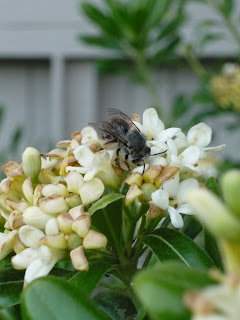When I went to Alaska back in 2002, I had torn a ligament and was hobbling around on crutches. This impediment prevented me from doing much hiking and probably was a big part of the reason that the only loons I saw in their summer breeding ground were on postcards in gift shops. Since that trip, I longed to see a loon. The internet told me that others had been lucky enough to photograph them off the Berkeley Marina, so I hoped it was only a matter of time before I was lucky enough to see one. And on Saturday, my day finally arrived!

My sister and her boyfriend spotted something on the muddy shore of the lake on their way to my house. "It's brown and fluffy," they said, "like a baby bird. But really big!" Despite the fact that they had been traveling for the past 3 hours, I demanded they take me immediately to this so-called "baby tern." They walked me over to what Tom and I have dubbed "turtle bridge" (where the stream runs under Broadway) and there on the mud was the cutest giant waterbird of my dreams...

... glancing sexily at us from over the shoulder. A Red-throated loon in its brown fluffy winter plumage! Now, there is only one thing wrong with this picture. Loons are water birds (in Britain they're called Divers) and, as you can see from the picture above, their legs are so far back on their bodies that they can't walk on land. Though it seemed alert and was preening vigorously, its terrestrial lounging cued us that something might be wrong with our fluffy new friend.

A call to the
International Bird Rescue Research Center in Fairfield confirmed that Loons Should Not Be on Land. The patient guy I talked to advised that we try to catch the loon and bring it in, if we could. He recommended throwing a towel over it and then grabbing it, taking care to hold it away from the face as it tried to kick and peck with all its ungrateful might. It could spend the night in a dark warm place and be brought over to the center when it opened in the morning. We readied some supplies:

The loon shyly watched me climb down the cement wall onto the squishy, mussel encrusted mud it had chosen as a hangout spot:

I threw the towel like a champion bird-catcher...

Aaaand the loon scooted penguin-style, on its belly, into the water and away from me. I was left holding the muddy towel, which now resembled a loon Shroud of Turin.

Looks like it wasn't so sickly after all! My sister got these last 2 pictures with her mighty 10X zoom.
Knowing that loons migrate in spring, on a journey that can stretch from Baja to Alaska, my best guess is that it was exhausted from a long flight and stopped for a breather and maybe a warm-up. I looked for the loon over the next few days but didn't see it again. May it have a safe journey up to Alaska and make a million babies!
 This is another bird that you might not notice right away (especially if you are expecting only seagulls). But you can often hear their distinctive calls, which they seem to make as they chase each other around (read "constantly.") If you get a closer look, you can see that they have forked tails, black heads, and wings so pointy they could be used as ninja stars.
This is another bird that you might not notice right away (especially if you are expecting only seagulls). But you can often hear their distinctive calls, which they seem to make as they chase each other around (read "constantly.") If you get a closer look, you can see that they have forked tails, black heads, and wings so pointy they could be used as ninja stars.


















































